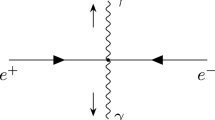Abstract
A screw model is developed for photons and fermions to offer a physical representation for the Feynman’s arrow scheme in quantum-electrodynamics. This model interprets intrinsic parameters of particles: spin, rest energy and magnetic moment by self-rotations with the speed of light forming either a helical (boson) or a spherical (fermion) screws. Due to the extreme Lorentz contraction, the surface of screws is zero, while the radius remains finite (Compton radius). According to the general theory of relativity, the non-Euclidean geometry of space–time caused by the self-rotation of particles should produce an intrinsic force, which is analogous to the gravitation, but being 32–42 orders of magnitudes stronger, we denote it as strong gravitation. It is a self-stabilizing force for the intrinsic rotations, which is the source of spin and defines the Planck constant. The spherical screws of fermions are formed by double rotations, where the two rotations have right or left-handed chirality representing the particles and anti-particles. The double-rotation produces Coriolis force, where the sign is determined by the chirality and this force is the origin of electric charge. Parity violation in the beta-decay of neutrons is related to the symmetry of reflection for the self-motion of particles. The finite radius of self-rotation may resolve also divergences in the theory of quantum-electrodynamics.


Similar content being viewed by others
References
R P Feynman QED, The strange theory of light and matter (Princeton: Penguin books, Princeton University Press) (1985)
A Zee Quantum Field Theory in a Nutshell 2nd Ed. (Princeton: Princeton University Press) (2010)
H J Bhabha Proc. Roy. Soc. A154 195 (1936)
A Arbuzov, M Bigi and H Burkhardt et al. Phys. Lett. B 383 238 (1996)
R P Feynman Quantum Electrodynamics New edn. (Westview Press) (1998)
A O Barut and Nino Zanghi Phys. Rev. Lett. 52 2009 (1984)
M Rivas J. Phys. A Math. General 36 4703 (2003)
N Hothi and S Bisht Indian J. Phys. 83 339 (2009)
A Einstein Annalen der Physik 49 769 (1916)
K Schwarzschild Sitzungsberichte der Königlich Preussischen Akademie der Wissenschaften 7 189 (1916)
P W Higgs Phys. Rev. Lett. 13 508 (1964)
P A M Dirac Proc. Roy. Soc. A117 610 (1928)
T D Lee and C N Yang Phys. Rev. 104 822 (1956)
L Foldy and S A Wouthuysen Phys. Rev. 78 29 (1950)
H Bethe Ann. Physik 395 133 (1929)
L K Gordon Modern Elementary Particle Physics (Perseus Books) (1987)
G Joos and I M Freeman Theoretical Physics (New York: Courier Dover Publication) (1986)
C M Sommerfeld Phys. Rev. 107 328 (1957)
G Gabrielse, D Hanneke, T. Kinoshita, M Nio and B Odom Phys. Rev. Lett. 97 030802 (2006)
R P Feynman, R B Leighton and M Sands The Feynman Lectures on Physics (Addison-Wesley Publishing, Massachusetts) Vol. 2 (1964)
R P Feynman Phys. Rev. 74 1430 (1948)
M H MacGregor Foundations Phys. Lett. 2 577 (1989)
Author information
Authors and Affiliations
Corresponding author
Rights and permissions
About this article
Cite this article
Rockenbauer, A. A screw model for quantum electrodynamics: from gravitation to quanta. Indian J Phys 89, 389–396 (2015). https://doi.org/10.1007/s12648-014-0598-z
Received:
Accepted:
Published:
Issue Date:
DOI: https://doi.org/10.1007/s12648-014-0598-z




